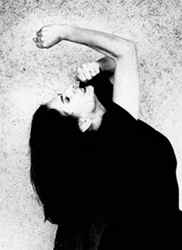Black Legend at the Southern: Beautiful Politics
Kim Surkan saw Tales of the Black Legend, by Zorongo Flamenco at the Southern Theater. Zorongo brings off the over-the-top drama with politically relevant passion rather than camp.

It’s hard to imagine a form of dance more dramatic than flamenco, which makes it the perfect medium for dance theater. Susana di Palma knows this better than anyone, and the artistic director of Zorongo Flamenco Dance Theatre puts her company to the test again in “Tales of the Black Legend.” The show, onstage at the Southern through this weekend, takes audiences back to the history of the Spanish Inquisition in a vibrant and sometimes chilling reminder of the persecution of difference at the hands of the Catholic Church.
“Tales of the Black Legend” is a large-scale production that takes risks and actually pulls them off. With a cast of fifteen, including dancers, singers, and musicians performing live onstage, the show is an impressive collaboration of artists. Performers enact historical roles from fifteenth-century Spain to tell the story of Dominican priest Tomas de Torquemada and his attempt to purge Spain of heretics, gypsies, Moors, Jews, mystics, witches, and anyone who dared to profess beliefs contrary to Catholicism.
Guest dancer Myron Johnson, who many Twin Cities dance regulars know as the artistic director of Ballet of the Dolls, is a stunning and imposing Torquemada. Otherwise known as the Great Inquisitioner, he whirls about the stage, in duet with di Palma as La Patria, and breathtakingly in a self-choreographed solo, Tanguillos.
The condemned are made to dance before being led to the stake mounted in the center of the stage and burned in a flash of synthetic fire. Each segment of the piece tells a different legend or element of history, such as the tale of La Susannah (Deborah Elias), a woman born into a non-Catholic (converso) family. Her allegiance shifts from her revolutionary father (David Jordan Harris) to her Christian lover (Raul Salcedo), and she betrays her father, only to watch in horror as he is burned at the stake. Harris sings a haunting melody as he is led to his death.
Other guest artists in this production include flamenco singers La Conja and Jesus Montoya, who together with Pedro Cortes and Sean Kupisz transformed the space. At times it is difficult to believe such a rich and full sound could be coming from so few musicians.
Although some of the unison dancing could be tighter at times, solos by di Palma and Jose Moreno as the Last King of the Moors are really standout performances. Flamenco, a highly rhythmic form of dance, relies on precise percussive footwork, and these artists perform with breathtaking energy.
In choosing the Spanish Inquisition as a theme for this work, di Palma sought to make a connection between the history of persecution in Spain and “the rise of anti-Semitism again in Europe, hatred of “Los Moros” in Spain, and the rise of religious fundamentalism and intolerance in our own country.” What a beautiful way to make a political statement.